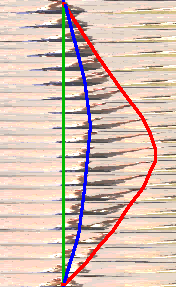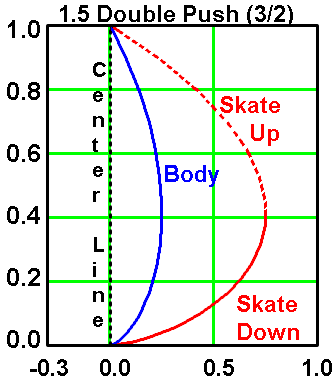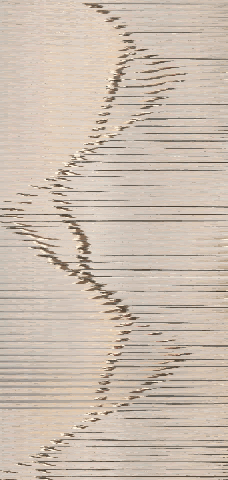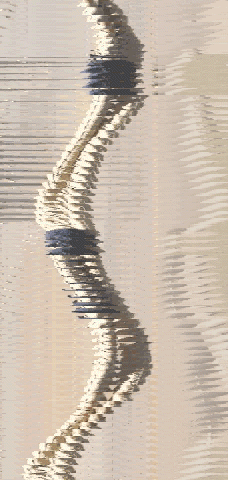The Optimum Skating Stroke.
c. P. J. Baum, August 2000.
8/10/2000
Introduction And Approach
Recently I found that several strokes could be fully efficient. Specifically, I gave solutions for Fully Efficient Classic and Double Push Strokes using a two-dimension energy conserving model. So here I am looking for effects other than efficiency which might make one stroke optimum.
It was found earlier that the skater's cross section for wind drag increases in Double Push, and, in addition, the body's path becomes more and more serpentine as the Double Push limit (the "2.0 stroke") is approached so that the path length travelled through the air becomes considerably larger than for the single push stroke. I concluded that as the speed increases the skater must move his stroke back closer to Classic or single-push which I called the "1.0 stroke" in order to avoid serious wind drag problems.
Here I will look in more detail at a stroke which Chad has used (captured on video) and compare it with others to see how much the optimum stroke requirements can be nailed down. Chad's stroke is identified as the "1.5 stroke" or "three-halves stroke" on my scale.
As in the previous analyses I match the skater's energy to a linear accelerator and calculate the paths that two masses (representing the skater's body and his powering leg) must follow in order to be fully efficient.
Analysis And Analytical Results
1. Previously Examined Strokes
These stroke solutions are all presented on the same (dimensionless) scale with the forward space axis pointing up and the sideways space axis pointing to the right. All the strokes are done at the same Force, the same total mass, and the same stroke frequency. The only parameter which varies with forward motion is the stroke width or sideways position. Each example case uses the particular
mass ratio M/m = 4. The case on the left looks at the Double Push limit where the body and skate have equal sideways excursion and they are in phase. The middle panel is pure Classic where there is no sideways motion of the body. The right panel I am calling an antiphased Double Push which seems not useful and is ignored here.
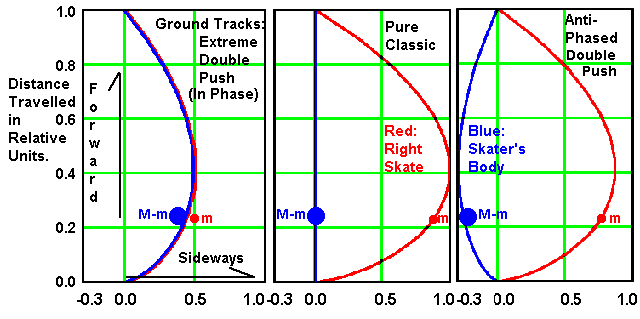
1a. Stroke Classification
The Double Push limit or 2.0 stroke (Left, above) and the Pure Classic stroke or 1.0 stroke (Center, above) can be thought of as the limits of speedskating. The figure below shows part of the continuum between these two styles. Pure Classic is on the top line, labellel 1.0 for single push, with the body shown on the far left and the skate on the far right. The skater's center line for his forward motion is upwards along the arrow. The stroke has pushed out to the right. Each horizontal line shows only the maximum stroke at one instant of time. At the very bottom of the graph we find two equal pushes by the body and the powering leg and it is labelled 2.0 for the Double Push limit. It is clear that the body's and leg's stroke can take on a range of values and they are shown on the lines which are labelled 1.1-1.9 . For example, in the 1.1 case there are two pushes ( so I place it in the inverted triangle region for Double Push). But the 1.1 stroke is very near the single push limit, 1.0, because the body's push is rather weak with a short sideways excursion.
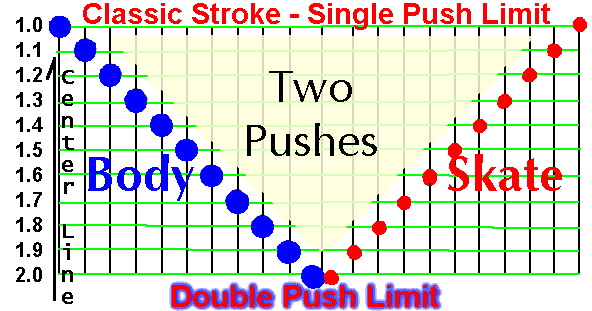
2. Chad's Stroke
For this section I rely on a video of Chad Hedrick taken by Kim Hendrikse called "chadstreet.mpg". You are encouraged to download it and view it for your personal non-commercial use (It is about 6 Megabytes in size). Suggestions for viewing this clip and an important video notice are given at the bottom of the page.
The figure on the left below was prepared from the video above. One half-cycle of his stroke was cropped to include the lower half of his body. This was exported to a filmstrip and vertically compressed so that the Time Tracks of his body and skate can be seen simultaneously. The blue curve shows the body track and thr red curve is the skate track. The right side graph is the fully-efficient solution for the 1.5 or three-halves stroke from my model. It seems to match Chad's stroke here reasonably well. More will be said later about the dashed part of the curve where the powering skate is lifted off the ground.
The graphs below are simulteous skate tracks (left) and body tracks (right) covering a full skating stroke cycle. Here the video was separately cropped to include only chad's skates and then only his waist. The few frames which are dark blue rather than cream indicate that the camera position shifted upward catching Chad's dark blue T-Shirt rather than his cream shorts. The right side shows that the body track is very nearly sinusoidal. From the left figure we see that one skate is in phase with the body while the other has no phase defined. I take this to mean that he is using the double push (one skate and the body powering) and not the triple push here. How the body powers will be discussed in a later page.
Discussion and Conclusions
Because of the range of ways in which the two pushes can be combined it is clear that there can be more than one style of Double Push. The classification scheme presented in the previous section allows us to categorize the skating style between 1.0 and 2.0 based on the amount of sideways push delivered by the skater's body. There is no body push at 1.0 while the body push equals the leg push at 2.0. The advantage of the Double Push is that it spares the leg muscles as they do not have to work as hard as they would in classic. But there is a downside also: Because the powering skate is closer to the body in Double Push the knees need to be bent less and the skater tends to stand up more and more as the stroke increases from 1.0 to 2.0 . Consequently the 2.0 stroke double push limit is subject to serious wind drag.
In a figure earlier on this page I showed a dashed region where Chad's outer skate is lifted off the ground. This is related to the classic or 1.0 stroke also as the skater does not return his powering skate on the ground there either. But there is a difference -- in classic there seems to be no power generated while the skate is off the ground. This can result in a duty cycle of only about 50% from the dead time while the skate is returned to the center line. It seems that it is difficult to power by pulling on the outside skate. Chad does it differently however: If you look at the ChadStreet.mpg video you see that he is cornering on the skate under his body. However, in the 2.0 stroke (where the body is over both skates) the cornering for the return can be done by pushing on the heel and using the cornering force to provide the pull force. This possibility does not exist for pure classic as the body stays in a straight line with no cornering, especially on ice where the skates do not turn very sharply.
Chad's 1.5 stroke splits the difference between pure Classic (1.0 stroke: low wind drag, low duty cycle) and pure double push (2.0 stroke: high wind drag, high duty cycle). It may be an optimum stroke but until the wind drag losses are know for the different strokes it can't be determined with certainty.
Video Viewer and Important Notes
There is a remarkable free program for operating on and viewing video clips like that of Chad (at a variable frame rate controlled by the mouse) called VirtualDub. The current version is 1.3d however version 1.3c was even more remarkable as it would convert mpeg to avi, convert asp files and more. Version 1.3c is still available elsewhere on the internet if you search hard enough. Newer video codecs for VirtualDub are available at The Codec Zone and these include mpeg4, Intel i5, Intel i263, and a lot of others. Here also you find a letter from Microsoft posted directing them to remove some Microsoft .dll's which were available for public download. The main object under attack is a video dll called
"MPG4C32.dll", and specifically, Version 4.00.0.3688 . This dll contains the guts necessary to view and operate on avi files. It seems that Microsoft has declared war on the avi file format and has rewritten newer versions of this dll so they will not operate on avi files. They consider the avi file to be obsolete. If you have a collection of avi files or use an avi editor you need to store a copy of this dll. I found a copy on the internet after an hour or two of searching but most copies have already been deleted under pressure from Microsoft. Beware of downloading recent versions of Microsoft video/multimedia software. The new Media Player version 7 will replace your Win/Sys/ dll's with versions that will not operate on avi files. In addition, if you search the small print on the microsoft site you discover that the current version of Media Player 7 is incompatible with Easy CD Creator version 3.5 so you may not be able to write anything to CDR.
Click to go back to the INDEX

Используются технологии
uCoz


